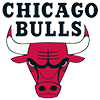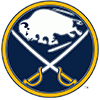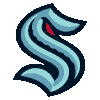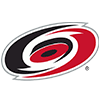Recall the premise of this annual series of bold predictions stated in the first installment:
It's time, once again, to put myself out there and make 60 predictions for the new season. The premise for this annual article series remains the same: the prediction has to be somewhat grounded in reality but at the same time viewed as unlikely when you first read it. So, you will not find me predicting Ryan Yarbrough to win the Cy Young, but you may see me making calls predicting a breakout for Corbin Burnes as I did in this series just last year. Conversely, you will find some big misses such as me laying out the case why Shane Bieber would not finish the season as a top-20 starting pitcher.
When you play in the margins with predictions, you are going to lose more than you will win. The last three seasons, I've hit on 21 to 24 of the 60 predictions I've made with some rather big hits (Renato Nunez, Blake Snell, Lance Lynn, Jose Abreu) and many more misses. Just last year, this series helped identify the upside of taking a chance on A.J. Pollock, Andrew McCutchen, Asdrubal Cabrera, Ian Happ, Marcell Ozuna, Trent Grisham, Chris Bassitt, the aforementioned Burnes, Tony Gonsolin, and Justus Sheffield.
While I strive for higher rates of accuracy, you will not see me lower the credentials for predictions to increase the
Recall the premise of this annual series of bold predictions stated in the first installment:
It's time, once again, to put myself out there and make 60 predictions for the new season. The premise for this annual article series remains the same: the prediction has to be somewhat grounded in reality but at the same time viewed as unlikely when you first read it. So, you will not find me predicting Ryan Yarbrough to win the Cy Young, but you may see me making calls predicting a breakout for Corbin Burnes as I did in this series just last year. Conversely, you will find some big misses such as me laying out the case why Shane Bieber would not finish the season as a top-20 starting pitcher.
When you play in the margins with predictions, you are going to lose more than you will win. The last three seasons, I've hit on 21 to 24 of the 60 predictions I've made with some rather big hits (Renato Nunez, Blake Snell, Lance Lynn, Jose Abreu) and many more misses. Just last year, this series helped identify the upside of taking a chance on A.J. Pollock, Andrew McCutchen, Asdrubal Cabrera, Ian Happ, Marcell Ozuna, Trent Grisham, Chris Bassitt, the aforementioned Burnes, Tony Gonsolin, and Justus Sheffield.
While I strive for higher rates of accuracy, you will not see me lower the credentials for predictions to increase the chances of the prediction coming true. My goal is not to go 60 for 60 on these; it is to get you thinking differently about each one of these players. Statistical predictions in player capsules or writeups are, at best, within the range of accuracy 70 percent of the time. My purpose is to get you thinking about what could potentially happen in the other 30 percent of the pie.
The small sample of 2020 compounded with all of the related factors in prepping for and playing through a season during a pandemic loom large in the statistics, which is why you'll see a focus on timelines rather than solely focusing on the previous season.
All ADP references come from 164 drafts over the past 60 days:
Baltimore
Freddy Galvis (ADP 564; high 360, low 631) is a top-25 shortstop. Galvis is currently the 47th shortstop off the board or the 55th second baseman, as he has dual eligibility this season. Galvis recently signed in Baltimore on a cheap one-year deal, and ideal spot for his fantasy potential. Galvis is going to play everyday for a club that is clearly not going anywhere in 2021 and is a nice stop-gap for it to allow Jahmai Jones some more development time in the minors before rushing him up to the big-league level.
The switch-hitting Galvis has hit at least 20 homers in two of the last four full seasons, but his stolen-base production has waned with his age and is no longer a factor in his stat line. The 23 homers he hit in 2019 would have been two higher had he played his home games in Baltimore. Galvis worked on some things in 2020 we have never seen from him before in that he posted a career-high walk rate
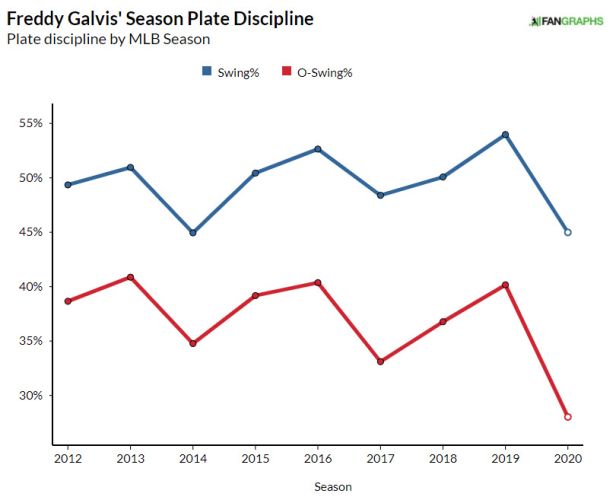
Galvis did not realize any results in his batting average, but did squeeze out a career-high ISO. Galvis will take over the spot vacated by Jose Iglesias who came to Baltimore under similar circumstances and flourished in the everyday shortstop role with a surprising run of batting average success. Galvis will not win any batting titles, but he will play every day and likely hit fifth or sixth while enjoying the comforts of the AL East ballparks, which include the short porch in Yankee Stadium as well as the short porch in Dunedin, Fla., where Toronto appears likely to spend a good chunk of this season.
Tanner Scott (ADP 631; high 361, low 741) is a top-150 pitcher. Scott is currently the 244th pitcher off the board, but a pitcher with upside. He has worked in 102 innings the last four seasons with Baltimore, striking out 30 percent of the hitters he has faced (while walking 13 percent) and holding hitters to a .247 average in mostly low and medium leverage work. Scott had a strong showing in 20 innings last season with a 1.31 ERA and 1.06 WHIP around just a single save.
Scott, like many relievers, has his flaws. The good stuff from him includes a career 50 percent groundball rate that has increased each of the previous three seasons, which is handy for relievers pitching in Camden and the AL East. The career-high 58 percent groundball rate in 2020 turned him into a contact suppressor as he saw a significant improvement in opponents' ability to make hard contact off him. He also owns fastball spin and velocity in the top 10th percentile and a slider that can make hitters look silly if they are sitting dead red. The bad stuff for Scott is mostly around his problem with walks and that his fastball becomes more hittable when the league knows it is coming. That was the case in 2019 when the league hit .386 off Scott's heater because he pitched from behind more often than not, but then saw the league hit .212 off the same fastball in 2020 because he didn't allow himself to fall into so many hitters' counts.
The depth charts have Hunter Harvey as the presumptive closer for the season, but Harvey has all of 15 innings of major league experience. Scott is not the only lefty on the club (Paul Fry), which means Scott should not be trapped into a non-closing role due to his handedness. Scott should be in many eighth or ninth innings for Baltimore this season and has the stuff to be a productive closer if provided the opportunity. In terms of friction, there is very little in the way of Scott's journey from middle relief to the full-time closer role.
Boston
Bobby Dalbec (ADP 294; high 205, low 438) finishes outside the top 350. Dalbec is the 30th first baseman off the board going just behind Yuli Gurriel and in front of the multi-positional Tommy La Stella. Dalbec showcased his massive raw power in 2020 hitting 8 homers while slugging .600 over 92 plate appearances in the back half of the season. Dalbec has made a professional career out of mashing the baseball as he hit 32 homers between High-A and Double-A in 2018, and then hit 27 homers between Double-A and Triple-A in 2019. Power has never been a problem for the first baseman, but strikeouts have been very prevalent.
Dalbec saw his strikeout rate worsen from 23 to 28 to 37 percent in the first three levels of his professional career. He "improved" things to 31 percent in High-A before falling back into issues in Double-A at another 37 percent strikeout rate along with a 5 percent walk rate. 2019 saw significant improvement as he lowered his strikeout rate to 25 percent in Double-A and 24 percent in Triple-A. The major leagues was a different story as Dalbec struck out in 42 percent of his plate appearances and his whiffiness was noticeable. He swung and missed at 39 percent of the fastballs he faced as well as 55 percent of the non-fastballs he faced.
Striking out in 40 percent or more of one's plate appearances is not as infrequent as you may think. In fact, 23 players struck out at least 40 percent of the time (min. 80 plate appearances) the last 10 seasons:
- 2012: Brett Jackson, Brett Hayes, Brooks Conrad
- 2013: Rick Ankiel
- 2014: Javier Baez
- 2015: Joey Gallo, Drew Stubbs, Carlos Peguero
- 2016: Aaron Judge, Drew Stubbs, Tyler Austin
- 2017: Franchy Cordero, Rickie Weeks, JaCoby Jones
- 2018: Tom Murphy, Drew Robinson, Brett Phillips, Dilson Herrera, Tyler O'Neill
- 2019: Keon Broxton
- 2020: Miguel Sano, Bobby Dalbec, Jo Adell, Evan White
That is a wide range of outcomes with Judge, Gallo and Baez at the front of the spectrum and many others at the other end. Only Gallo struck out with that kind of rate in the minor leagues, so Dalbec faces an uphill climb of avoiding the future that many others on this list ran into, or following in O'Neill's footsteps as his talent is still trying to catch up to major league pitching. Dalbec's range of outcomes varies from 30 homers to spending most of the season in the minors. There is really no precedent for a prospect with his swing and miss, which makes this a risk you should let your competition take.
Nick Pivetta (ADP 535; high 337, low 597) is a top-150 pitcher. Pivetta is the 202nd pitcher off the board, going just after Kohei Arihara and just before Clarke Schmidt. I had penciled in Pivetta for this prediction a day before this tweet hit the twitterverse:
A sentence in The Athletic today:
— Red Sox Stats (@redsoxstats) February 8, 2021
"the Rays tried hard to beat Bloom to Pivetta; 'we think he can be another Glasnow,' said a Rays official."
This is not the first time I have used Pivetta in a bold prediction, but perhaps this time it will pan out. Pivetta had a solid 20 percent K-BB% in 2018 with a 3.80 FIP, and I thought great things were ahead for him in 2019 and he rewarded me with a 5.38 ERA and being banished to the bullpen. 2020 was all of 15.2 innings, but it was night and day efforts for Pivetta. He made three relief appearances for the Phillies before the trade to Boston, and then he made two starts for Boston to close the season:
- 9/22 vs Baltimore: 5 IP, 4 H, 1 ER, 3 BB, 8 K
- 9/27 vs Atlanta: 5 IP, 4 H, 1 ER, 2 BB, 5 K
Boston immediately had Pivetta throw his slider as a secondary pitch whereas the pitch was an afterthought in Philly:
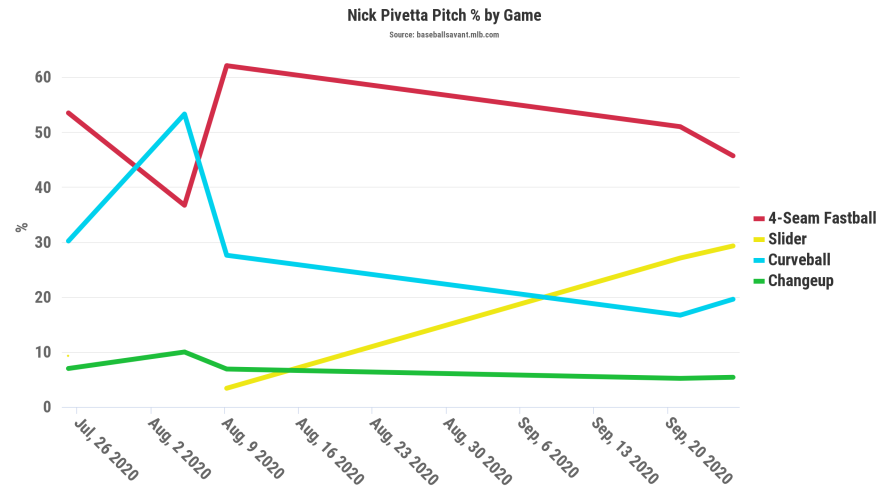
Pivetta ended up getting a career-high swing-and-miss rate (albeit over 2 games) with the pitch.
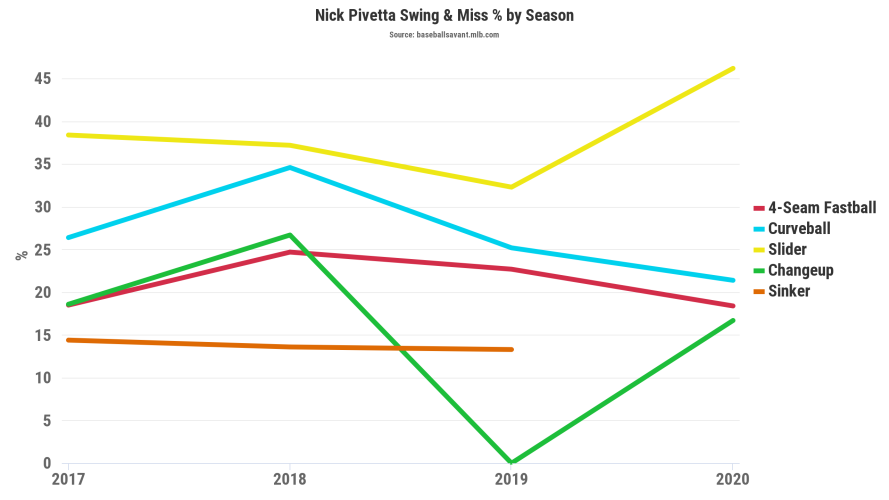
The Red Sox clearly saw something when they traded for Pivetta, so we can expect them to encourage more slider usage as they attempt to do with him what they have done with Nate Eovaldi. The change of scenery, coaching and repertoire could finally allow Pivetta to pitch to his full potential.
New York
Gio Urshela (ADP 159; high 109, low 221) is a top-100 player. Urshela is the 18th third baseman off the board, going just behind wunderkid Ke'Bryan Hayes and just in front of the recently traded Andres Gimenez. Urshela has put together two surprisingly productive years after showing little ability to hit major league pitching in Cleveland or Toronto. The production with New York is real, but so is his offseason elbow surgery that he had to remove a bone spur in his throwing arm.
The surgery required Urshela to shut things down for an extended period of the offseason and his availability for Opening Day is in question. We've already seen the player saying "feel great!" in stories, but it would be best-case scenario for him to make the Opening Day roster. That is where the discount is baked in with his current ADP. Players in the top 20th percentile of most outcome-based measures should not be this low in ADP charts, especially players who can hit to all fields in a home ballpark like Yankee Stadium.
He had success last year despite a drop in outcome-based production off fastballs, but expected stats show, at least by xBA, he was the same guy. This is where we perhaps see the elbow spur coming into play as his ability to hit those fastballs with the same kind of thump as 2019 was diminished:
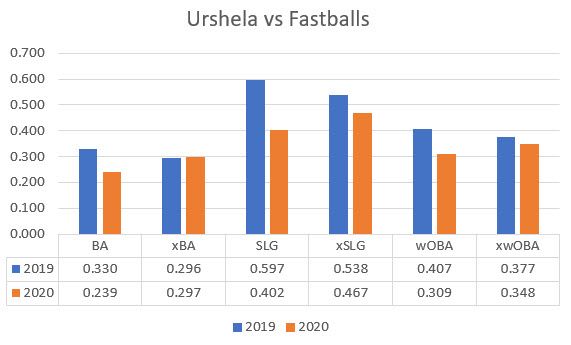
Look, it is no secret I despise the Yankees and their big budget ways, but I have noting but respect for this guy at the plate and in the field. He would hit higher in the lineup in most other organizations and could even do that here when (not if) the injuries start rolling in for the Yankees, as they tend to do each season. Hitting eighth in most lineups is a curse, but in this lineup, he is a second cleanup hitter. There is even a case to be made that it should be Urshela and not Aaron Hicks hitting higher in the lineup. Both have the OBP skills, but Urshela has the stronger ability to hit for average and make contact to keep the top of the lineup moving along.
Corey Kluber (ADP 220; high 94, low 324) is not a top-125 pitcher. Kluber is the 82nd pitcher off the board, going just after Marcus Stroman and just in front of Jose Urquidy. Kluber has thrown a total of 36.2 innings the last two seasons after five consecutive 200-plus inning seasons due to two different arm injuries — one skeletal and one muscular. He reminded us that even the most reliable pitchers can break down, just like Justin Verlander in 2020.
Kluber's skills were elite in his dominant run through most of the last decade until he got off to a terrible start to the 2019. The strikeouts were still there, but his normal pinpoint command was not, and batters simply started laying off some of his pitches he normally got them to chase out of the zone:
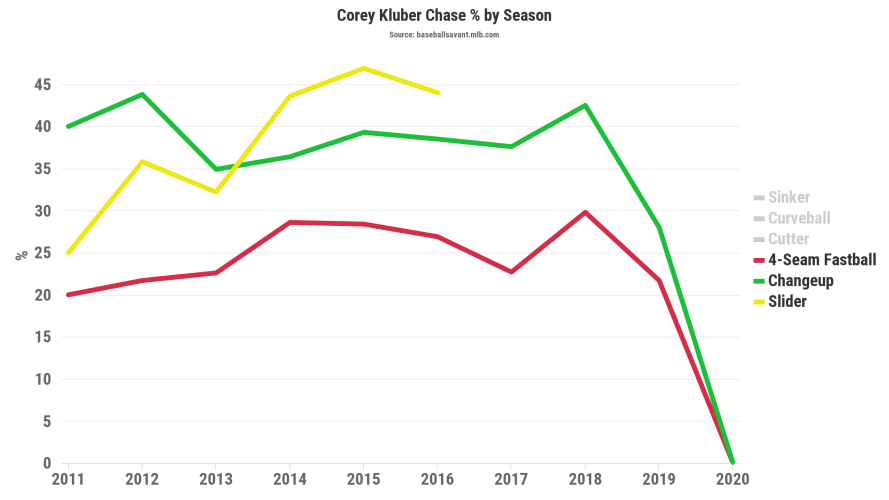
To be fair, the four-seamer and changeup were Kluber's fourth and fifth pitches in 2019, but the hitters decided they were not going to chase those pitches as they had in earlier seasons, and the league hit .385 off the fastball and .273 off the changeup with the approach. Kluber's only truly effective pitch in 2019 was his curveball (.176 avg) as the league hit .273 or better off everything else he threw. Kluber's velocity has waned in recent years, from a peak of 94 back in 2014 to 92 in 2019. His offseason workout that landed him his 2021 contract had him 88-90 in December:
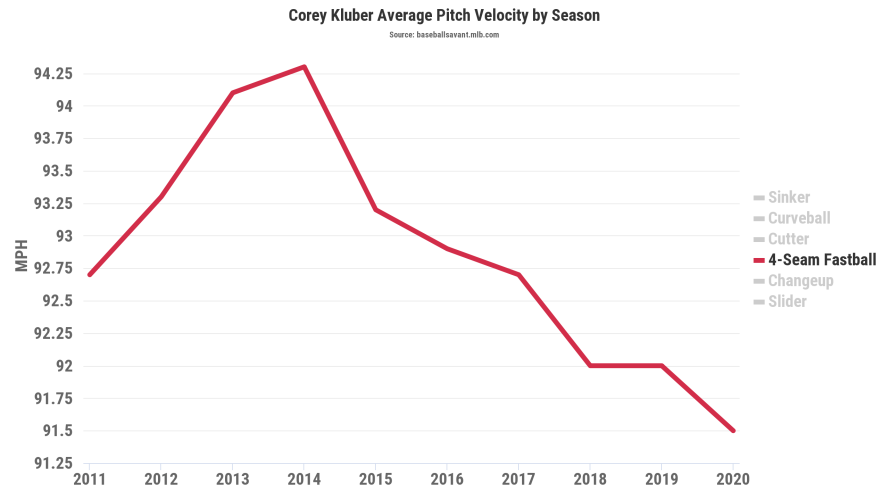
He has had essentially a two-year layoff from pitching, and none of the actual results when he has pitched have been worthy of his current ADP. Velocity is not everything for Kluber, but hitters have to be willing to chase his artwork on the corners for him to be successful without it. He can still throw his five pitches, but if the velo separation of the grouping is just six miles an hour, he will have to rely on location and shaping of the pitches to reclaim his fading glory. I am passing.
Tampa Bay
Taylor Walls (ADP 750; high 696, low 741) is a top-400 player. The Rays have had a habit of keeping Swiss army knife players around on the roster. Ben Zobrist, Sean Rodriguez, Brad Miller, Logan Forsythe and presently Joey Wendle are players who come to mind who started grabbing playing time wherever they could and ended up with larger than expected roles down the line. Walls is likely never going to hit for much power, but the switch-hitting prospect has a solid hit tool for average, can get on base, steal bases and his defense is already major league ready.
There has been smoke around trade rumors with Willy Adames because everyone is trying to clear a path for Wander Franco, but Franco can't play short like Walls can, and a trade of Adames would likely clear the spot for Walls to allow Adames to take over second base once all the service time "development" clears. Walls has the flexibility to play three infield positions if needed, and that flexibility plus his switch-hitting capabilities could earn him a job on the major league roster sooner rather than later depending on what other roster moves are made by the club.
Walls is going so late in drafts he is essentially undraftable in many formats, but you need to keep an eye on him. A trade of either Adames or Kevin Kiermaier sets some dominoes in motion (Margot to CF, Lowe to RF opening up second base) where Walls could see a significant bump to his playing time. It would also not be surprising to see him and not Franco up first from the farm if the situation calls for a replacement middle infielder.
Joe Ryan (ADP 707; high 498, low 748) is a top-200 pitcher. Ryan is the 303rd pitcher off the board, just behind Wade Miley and just ahead of Hansel Robles. Rays pitchers and their fantasy values are skewed by how the team utilizes their pitchers. Tyler Glasnow is in his own class and truly the only one you can draft on pure projection and stuff. Ryan Yarbrough is more valuable when pitching behind an opener, and his stats back that up. Nick Anderson has the stuff to close, but his postseason was rough and the club has always eschewed normal relief usage. The wins and saves likely will once again be well-distributed across the roster, which is why I am going to go with the kid who has yet to throw a major league pitch for this prediction.
This video interview has some nice clips of Ryan in action from the minor league mound. You see a lot of fastballs in the video because that is what Ryan does as he throws the pitch more than 70 percent of the time, according to Eric Longenhangen's scouting report at FanGraphs. He also mentions that Ryan's fastball has some ride to it, which causes hitters to swing under it, and that Ryan's fastball had the highest swinging-strike rate in the minors during the 2019 season. Ryan leveraged that fastball to lead all minor league pitchers in strikeout rate in 2019, striking out 38 percent of the hitters he faced, and leveraged that to also lead the minors in K-BB% by 3.4 percentage points over Tarik Skubal.
Tampa Bay has made it clear it is looking for pitchers who can work their pitching plan, which is multiple innings multiple times a week. They did not sign Michael Wacha and Chris Archer with any dreams either pitcher would be working six or seven innings an outing as they once did. Tampa Bay needs pitchers who can work one to three innings in relief after the first pitcher, and Ryan is perfectly suited for a trip through the batting order multiple times a week with his starting pitching pedigree. Those pitchers are going to be the ones getting wins, just like Colin Poche in 2019 when he came up with an even heavier tilt to fastballs and won five games while saving two others in less than 52 innings. Poche took his lumps with homers while throwing fastballs 88 percent of the time. Ryan could experience some similar tough love, but he feels like just the guy who sneaks up on us during the season like others before him.
Toronto
Bo Bichette (ADP 24; high 12, low 40) is not a top-50 player. Bichette is a supremely talented player, and at least one NFBC drafter believes he is a first-round talent. I have my concerns around a few areas. The knee injury last year does not concern me as he looked back to normal upon his return, but the four percent walk rate does. The Toronto lineup loaded up this offseason, and should Bichette continue his lower OBP ways, there are no guarantees he stays up high in the lineup.
The projected lineup in Toronto has Bichette hitting third behind stronger OBP guys, such as George Springer and Marcus Semien, and in front of Teoscar Hernandez. Meanwhile, OBP machine Cavan Biggio is projected for the sixth spot in the lineup. Yes, Biggio has his issues with strikeouts, but he excels at getting on base and has his own power and speed skills. Biggio has finished inside the top 25 in both seasons at the big-league level in pitches seen per plate appearance, which is not a skill that typically lives in the bottom half of the lineup that has his overall skillset.
The other matter is Bichette hitting third will impact his stolen base production, which is a big part of his current market value. Bichette is 8-for-13 in steals at the big-league level, which is not the kind of rate that dictates a green light anytime he is on first base. 2019 saw five players steal at least 10 bases while primarily hitting out of that spot in the lineup: Elvis Andrus (22), Starling Marte (17), Adalberto Mondesi (16), Bryce Harper (11) and Shohei Ohtani (10.) Teams simply do not risk the chance of an out that often sending the runner in front of the cleanup hitter, not to mention the chance of the traffic on the basepaths in front of Bichette should Springer and Semien produce at career levels. He has five-category potential in his career, but either he gains steals while losing runs and RBI chances, or he loses the steals but improves his run production based on his lineup spot. How you draft him accordingly determines on how you plan to construct your roster but if he drops down the lineup and still does not get the green light, that first- or second-round pick is going to sting quite a bit.
Julian Merryweather (ADP 744; high 564, low 749) is a top-250 pitcher. He is the 365th pitcher off the board, behind John Curtiss and in front of Justin Verlander, who will not even pitch this season. When I told podcast partner Justin Mason I was including Merryweather in this piece last Sunday, he replied, "You keep driving that bandwagon." Merryweather was the guy the Jays got when they traded Josh Donaldson but only finally made it to the majors in 2020 to pitch 13 innings before the injury bug stepped up to end his season.
Merryweather has been a starter throughout his entire minor league career, but one that has broken down quite a bit. He needed Tommy John surgery in 2018, but was touching 100 in relief last year for Toronto and throws four pitches with his starter background. Scouting summaries grade his fastball, slider and changeup at 50 or better on the 20-80 scale, and the club has said this offseason they value him as a starter. Given that the club has Tanner Roark and Steven Matz penciled into the rotation, it is not hard to envision a path forward for Merryweather should the team hold true to their thoughts and, more important, Merryweather's body holds up.
He ended 2020 season with elbow tendonitis, which they hope was just a byproduct of the 2020 craziness and not a leading indicator to another elbow surgery. He is 29, so his time is now. He is capable of doing this to major league hitters, or this to them, or this. He was used both as an opener and in late innings in his eight appearances in 2020, but I believe his role will be more prominent in either direction this year depending on his health.















